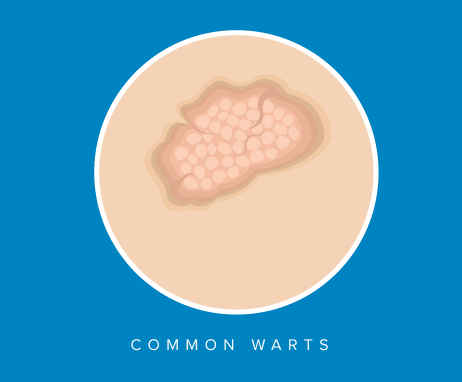

6 Common Types of Warts
Many people think of a wart as a raised, bumpy lump of skin, but warts come in different shapes and sizes. They can be flat or raised, smooth or rough and bumpy, and some warts have long, thin stalks growing from them. Some warts can be painful, too, especially in locations that experience frequent contact, like the feet or on hands and fingers.
It’s important to know that warts come from viruses in the human papillomavirus (HPV) family that enter through tiny breaks in the skin and cause a reaction. Warts are also contagious, which means they can spread to other parts of your body and other people, just like a cold or any other virus.
6 Different Types of Warts
At some point in your life, you may get a wart on your hands, on your feet or on another part of your body. If you do, here is how to tell what type of wart you have. This is important because not all warts can be treated with an at-home wart removal product. Some require a doctor’s attention.
1. Common warts
Common warts are the ones most people think of when they hear the word “wart.” These are often round, with a bumpy surface and grow on the fingers, toes, elbows, knees, and sometimes the face. People say this type of wart looks like a tiny cauliflower because it has a lumpy, rough surface. They tend to be grayish in color, and you may see dark specks that are very small, clotted blood vessels.

2. Plantar and palmar warts
Plantar warts are another type of wart many people have heard of. They appear on the bottom of the feet (plantar). Some plantar warts are small, grow in clusters and appear on the surface. Other plantar warts grow inward and can be quite painful. With these, you might see a small hole surrounded by hardened skin.
Palmar warts occur on the palms of the hands or fingers instead. These are sometimes caused by touching or picking at a plantar wart.

3. Flat warts
Like their name, flat warts are flat and smooth, not bumpy. They form in clusters on the face, backs of the hands, arms or legs, typically in groups of 20 to 200. Flat warts can be skin-colored or have tones of brown, pink, or yellow. While they are common in kids, they can appear in adults too, often as a result of the virus entering through tiny cuts made from shaving the face or legs.
4. Filiform warts
Filiform warts grow upward in stalks like very small, thin fingers. They tend to grow on eyelids or around the nose or mouth, but they can also grow on the neck or under your chin. These warts are flesh colored and often look like skin tags, especially in their early stages. Because filiform warts are located near your eyes, mouth or nose, you should call your doctor to find out treatment options. Do not try and treat these yourself, as most at-home wart removal treatments have ingredients in them that cannot go in or near the eyes, mouth or nose.
5. Periungual warts
Periungual warts are often caused by biting your nails or cutting nails too close to the skin. The HPV that causes warts then enters through small, often unseen breaks in the skin. At first, you may think these warts are just thickened skin around the toenails or fingernails. As they grow, you will notice a rough, cauliflower-like texture and the area may become painful as the wart puts pressure underneath the nail.
6. Genital warts
These warts appear on or around the genitals and are caused by a different form of HPV than the other warts listed here. If you have warts around your genital area (on or near the penis or vulva), you need to see a doctor. These cannot be treated by Compound W or any other over-the-counter wart treatment.
Treating Warts with Compound W
Warts can sometimes be tricky to treat, so you want to choose a wart removal treatment that easily and effectively removes warts. With Compound W wart treatments, you have options. Choose from liquids, gels, medicated bandages and even freezing methods that feature similar technology used in doctor offices.
You can use Compound W’s Treatment Finder to help pick the wart removal product that is right for you.


